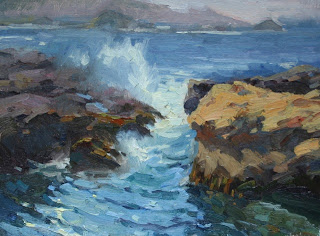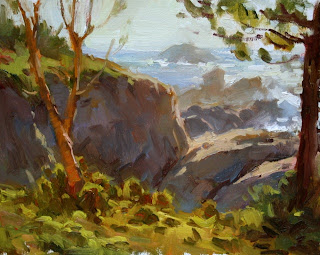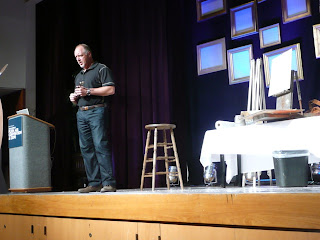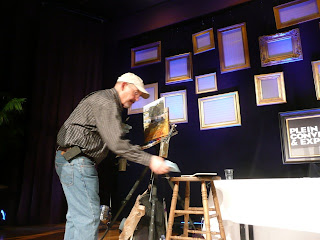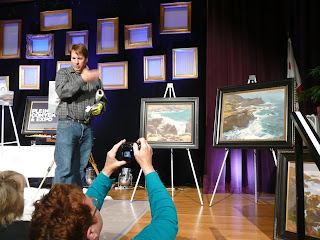 |
| On the way to Monterey I stopped to sketch at San Miguel Mission. |
After much debating with myself whether I should shell out 1K to attend the
Plein Air Convention in Monterey I decided it was just what I needed after filing for unemployment. After all, this might be the proverbial push to become a full fledged painter... I told myself. As scary as it is to take that leap of faith, it is what I dream about every single day and how much longer can I postpone the fact that to become an artist one must leave security behind.
Thomas Kitts offered sharing a room which would bring the cost down a bit so why not.
 |
| Overwhelmed by nature's drama. My first study at Cypress Cove. |
The Conference was organized in the following manner: Daily lectures/demonstrations by different speakers and artists occupy most of the day. Sometimes these demonstrations are simultaneous. I chose to attend those demos I was most interested in which meant I spent most of the day at the conference hall because the roster was very impressive. A hall of sponsors/brands offers their quality products at a discount during the thee days. Besides the demos and lectures there are also some paint-outs with the speakers . A great opportunity to see them in action for the benefit of everyone seeking advice or just learning.
 |
| Glenn Dean, John Burton and Thomas Kitts in Point Lobos. All at once!. |
When I arrived I immediately proceeded to spend most Wednesday painting in Point Lobos, a place I'm ashamed to say I had never seen. Incredible doesn't even cut it. I was so overwhelmed by the sheer magnificence that I went into frantic painting mode. But it was more of a coping mechanism than real art making I suppose because nothing came out right. I met
Glenn Dean and
John Burton in the beach painting a timed 20 minute sketch. I missed the first lecture by Joe Paquet (I regret that) but caught the James Gurney one on composition (based on eye-movement mapping and bias) . At 7pm there was a reception for the attendees and the excitement build up was palpable.
 |
| "Crown ad Anchor English Pub" to calm the excitement with Scotch,friends and the trusty sketch book. |
One of the main events for me was the marketing boot camp that took place at 6:30 am every morning. During this times, lectures on branding and marketing for artists were given by different experts. Among them,
Eric Rhoads,
Leslie Saeta,
Ed Terpening and
Elaine Adams. The main point I gleaned from them all is that artists tend to see the business side (selling) as crass and dirty but one doesn't need to perceive it that way or become someone else to do it. It takes a lot of work for sure and the lectures were a bit short on specifics but pointed in some directions that I might pursue. Not all of them. Magazine advertising, for example. Consistent magazine advertising might be great but I've heard both sides of the arguments for and against. Learning about the elements of a good website and newsletter was interesting. I would highlight Ed Terpening's clean presentation on how to maximize your online presence. Here is his generously published slide
presentation.
 |
| Peter Adams, President of the California Art Club. Talking about his commission to paint the Stations of the Cross in the L.A. Cathedral. |
|
|
Among the lectures that were not strictly demos, Jean Stern from the Irvine Museum on
Franz Bischoff , Peter Adams from the California Art Club on his Jerusalem trip and commission ,
John Stobart and
Mian Situ on their careers.... All very interesting from a documentary or aspirational point of view.
So there is something to be said about seeing so many artists demonstrating and speaking. A "cloud" of information to be sure but one that brought some points home. It's impossible for me in this blog to try to elaborate on everything so I will talk about what the highlights were for me personally.
Thursday, after our ungodly hour marketing bootcamp, we had the pleasure of attending a demo by Skip Whitcomb who is an amazing painter all around. My favorite quote of his, I paraphrase: "Everybody says you have to leave your first bad 7.000, 10,000 even, paintings behind. But in order to do that and become good you need to understand why they were bad. Otherwise it's like setting the toaster on one number forever and putting one slice of bread after another expecting they won't burn."
He emphasized the necessity to do a quick sketch first, to calm down and gather thoughts, not jumping into painting straight away. "There is NO TIME to work in a bad idea" when you are a professional painter and "baby needs some shoes". That makes prep work even more essential. You know when a painting has gone south because you start "futzing" with the little things. Noodling is a big red flag. Keep the big shapes clear, the main idea. Skip doesn't sell his studies, he uses them for reference.
I did really enjoy Skip's approach and professional attitude. His dismissal of those who brag about painting eight pieces a day "it's not a race, paint for yourself." His advice on looking at books and "filling up your well" before setting out as a way of finding a standard of excellence. Copying from the masters not as a repetitive task but as a way of discovering solutions.
Another impressive demo was that of
Peggy Kroll-Roberts, painting from the model (Ali, daughter of Ray and Peggy). She talked about her use of the mirror as a means to look at paintings as if someone else had done them and thus allowing the space to find errors. She talked about the importance of decision making. Sounds trite but deciding on what color or shape is something I struggle with and Peggy's work can be regarded as a constant exercise on decision. Likeness in a portrait is about the big stuff, not the small details. So again, big shapes, clear ideas and excellent draftmanship. She recommended
Loomis book on drawing. As it usually happens, now I see Peggy's work differently and appreciate the boldness of it.
Other demos I attended that day were offered by
Michael Godfrey who brought a semi-finished piece and talked about composition, painting on foggy days and creating mystery.
Alexey Steele did a drawing demo and
Rosemary showed how she makes her famous brushes .
Of course most of the fun conversation happens in the lobbies, where does Rosemary get her mongoose hair, what is it about BYU Art school that produces such accomplished painters; did they really rent a mule to go to the Sierras; is Wordpress the most economical way to set a website or build it yourself from scratch.; etc, etc.. And making new friends. I did make a few new ones like
Dave Tanner and meet up with some old ones like
Michelle de Braganca.
 |
| No lack of subject matter in Monterey. |

